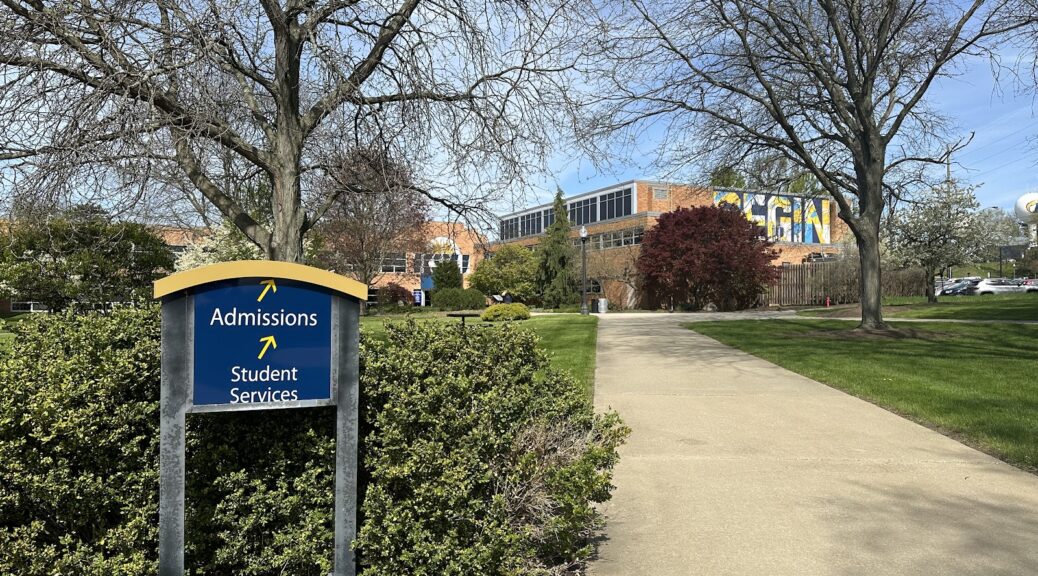
College Enrollment in Ohio: The drop, The Causes, and The Path to Revival
In the state of Ohio, the number of high school graduates has been remaining steady each year. However public colleges and universities have been experiencing a decline in enrollment.
According to the Ohio Department of Higher Education, over the past five years, the number of Ohio public high school graduates enrolling in Ohio public colleges and universities has decreased by approximately 14% from 55,000 in 2018 to 45,000 in 2022.
Mike Duffey is the current Chancellor for the Ohio Department of Higher Education. With there being multiple reasons why high school graduates are not attending college, a recent issue, according to Duffey, is the public confidence in postsecondary education.
According to Gallup, the confidence Americans’ have in higher education has fallen to 36% in 2023. 17% of U.S. adults have “a great deal” of confidence and 19% have “quite a lot” of confidence. 40% of U.S adults have “some” confidence and 22% have “very little” confidence.
“This impacts college-going rates. Ohio is similar to other states in this respect. It is, in other words, a national perception issue,” Duffey said.
Other reasons high school graduates are no longer choosing college are the price of tuition, the rise in economy leading to wage compression and the option of trade and technical schools.
Sean Broghammer is the Vice President for Enrollment Management at Kent State University and he finds tuition and student loans to be a big reason as to why enrollment has been declining for public colleges and universities.
“I wish there was more information shared about student loans because the majority of what is put out is driven by outliers, like people taking out hundreds of thousands in student loans, “Broghammer said. “Those numbers are not the norm.”
The numbers put out seem very high, so high school graduates are trying to stay away from student loans. They are also looking towards other options for their future.
Due to the rise in economy over the last few years, there has been a continuing wage compression, which is when federal or state minimum wages increase. According to Broghammer, this has lead more high school graduates to enter the workforce directly after graduation, rather than attending college.
“I think what is happening is many students in high school are really contemplating the value of going to college and whether or not it makes sense for them,” Broghammer said.
Students are also choosing the option of trade school to get into a career faster. Alexander Bittenbender graduated high school in 2022. For the last two years of high school he attended R.G. Drage, a career technical center in Northeast Ohio, to pursue welding.
“I found myself split between potentially wasting my time going for a degree for something I potentially would not like or use or try a trade like welding,” Bittenbender said. “If I did not like welding, at least I had a job that could help me afford college later down the road.”
“If I did not like welding, at least I had a job that could help me afford college later down the road.”
Alexander Bittenbender
While attending R.G. Drage for his junior and senior year, he was also given the opportunity to receive college credit and graduate high school with an associates degree from the University of Akron, with no cost. However he still chose to not pursue a 4-year college degree.
The cost was a big factor in Bittenbender’s decision. “Once I stepped into the workforce, I realized that many individuals with college degrees were making very similar salaries as I was,” Bittenbender said. “I have now decided that college is not worth it for me unless there was a particular subject or field I wanted to get into that required it.”
Bittenbender said technical school and heading into the workforce benefitted him from a young age. It set him up to work a job related to his schooling at 16 years old, making much more than the average person at that age.
“I think as time goes on more people have come to terms that college does not always equal success and can even cause the opposite,” Bittenbender said. “More people have realized it can put you in serious lifelong debt without any way to pay it off if they are not successful in the field they went to college for.”
With many opportunities for post high school leading to a decline in college and university enrollment, public universities like Kent State University have had to make cuts.
In addition to the statewide data, the Ohio Department of Higher Education shows enrollment for each individual public college and university in Ohio from 2012 to 2022, each experiencing a decline.
According to the data from the Ohio Department of Higher Education, one of the public universities experiencing enrollment decline is Kent State University. In 2012 they had 43,000 students enrolled. Ten years later, in 2022, they had 32,000 students enrolled.
Broghammer has been the Vice President for Enrollment Management at Kent State University since March of 2020. He has already experienced a couple of years of declining enrollment, since taking on the job at the height of the pandemic.
“I started the first day the university went remote, so going into that fall semester, we were a little bit concerned about what enrollment would look like,” Broghammer said. “The institution as a whole had been declining in enrollment.”
“The institution as a whole had been declining in enrollment.”
Vice President for Enrollment Management – Sean Broghammer
Due to the declining enrollment that has been happening over the past ten years, Kent State University has had to reevaluate expenses. The university’s revenue is driven by student enrollment and the State Subsidy for Instruction.
Each student enrolled is paying a tuition that is the main source of income for the university. The SSI, according to Broghammer, is money from the state of Ohio to support students going to college. Both tuition and the SSI help fund the university.
Each year the university looks at these two income sources, and if there is a decline, changes in spending have to be made.
“In my area we would look at supplies, travel budgets, money spent on recruitment activities and the admissions office,” Broghammer said. These changes happen on an annual basis.
One of the major changes the university has to go through is cutting staff. Before choosing specific staff to cut, the university first leaves it open to voluntary separations, this includes staff members choosing to retire early. The university does not fill many of the positions previously cut, as another way to reduce expenses.
“We attempt to do as much as we can to minimize the impact on what students experience at the university,” Broghammer said.
The enrollment data for the 2023-2024 academic year will not be published until the year is officially over. However, Broghammer said the fall enrollment for 2023 increased from 2022. “We anticipate seeing growth again as we go into fall 2024,” Broghammer said.
Even with the optimism for next year, colleges and universities are still watching for the enrollment cliff that is expected to happen after peak enrollment in 2025. The enrollment cliff refers to the projected decrease in college enrollments starting in 2025. Falling birth rates in the aftermath of the Great Recession and slowing immigration are the main reasons.
“What we’ve been prepared for is a reduction in the number of traditional age college students and fewer students choosing to go to college,” Broghammer said. “It is kind of a double reduction since there are fewer people and there are fewer choosing to pursue college after high school.”
According the Duffey, the decline after 2025 is mainly projected by the anticipated number of college age students. This does not include other factors that affect enrollment.
“Enrollment estimates that include nontraditional students, such as adults and those with some college but no degree, demonstrate the possibility of an increase in future enrollment, Duffey said. “While still early, we are encouraged by this possibility and focused on promoting opportunities to attract and serve nontraditional students.”
“Enrollment estimates that include nontraditional students, such as adults and those with some college but no degree, demonstrate the possibility of an increase in future enrollment.”
Ohio Department of Higher Education Chancellor – Mike Duffey
Over the next couple of years before the enrollment cliff will hit, Kent State University is hoping freshman numbers will continue to increase. The transfer student numbers have been stable along with positive growth at the graduate level. Broghammer hopes this can continue in the future.
“One thing that is clear about enrollment projections, however, is that it is difficult to predict with certainty what will happen at a given point in the future,” Duffey.


